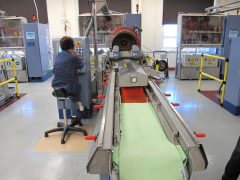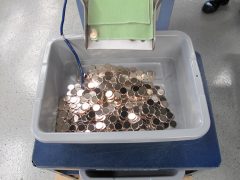A fortress-like exterior, a myriad of underground vaults, cool machines, gadgets and an assortment of coins make for an intriguing tour of the U.S. Mint at San Francisco.

But it’s the people there that hang onto your thoughts as you walk out of the building. The talent pool at the SF Mint is exceptional. It’s clear Mint employees enjoy their jobs and take pride in their work. The guy at the top there, plant manager Larry Eckerman, knows what he’s doing because he’s surrounded himself with top-notch people. As this article and the next couple in the series are more visual in layout, you’ll see a few Mint employees in some of the photos. Unfortunately, you can’t talk to them like I did. It was a treat.
Now, let’s get to the focus of this third article in a series of several about the U.S. Mint at San Francisco…
For the most part, major coin production stages at the San Francisco Mint are segmented into large rooms on various floors in the building. Among the largest rooms are those to prepare blanks, prepare coin dies, press coins and package proof sets.
Tons and tons of collector proof coins come out of the San Francisco Mint every year. I did some quick napkin math on U.S. Mint sales of the various proof sets for last year. The result, the SF Mint struck more than 20.1 million proof coins. To do that, more than 20 million coin blanks were needed. Simply described, blanks are the metal discs that are eventually pressed into coinage. Here is a photo walkthrough on how the SF Mint prepares its coin blanks for the presses.
Annealing Furnace
Two annealing furnaces in the U.S. Mint at San Francisco are the biggest and most important pieces of equipment sitting in the SF Mint’s 2nd floor Treatment Room, the area responsible for preparing coin blanks.

Blanks are heated to soften them up and enhance their internal structure. Without this annealing step, they would otherwise be too brittle and crumble in the press room. The photo above displays a portion of the furnace that conveys blanks for heating.
Directly below is a photo showing how they are fed into the furnace.

Unlike the days of old, SF Mint annealing furnaces are environmentally friendly even as blank molecules are excited in an oxygen-starved environment at temperatures ranging from 1050 degrees Fahrenheit to 1650 degrees Fahrenheit. For the technically minded, oxygen deprivation is necessary to minimize blank oxidation. The actual atmosphere within the furnace chamber is a combination of nitrogen (~96%) and hydrogen (~4%).
For a heat comparison, most home ovens reach up to 500 degrees Fahrenheit in broil mode. Unlike home ovens, the annealing furnace at the San Francisco Mint did not radiate noticeable heat or emit telling baking fumes. Imagine when that wasn’t the case…

Temperature settings for the furnaces are uniform only for a specific blank run. A run’s settings has to be adjusted based on the alloy of the coin blank. That varies for pennies, nickels, dimes, quarters, half-dollars and $1 coins, and whether they are clad or silver.

SF Mint electrically heated furnaces have built-in cooling. By the time blanks exit the annealer, they can be touched since their temperature has cooled to near 100 degrees Fahrenheit.
Upsetting Mill
After the annealing furnace, blanks that need a rim travel through a smaller machine that changes their shape and turns them into planchets. Called an Upsetting Mill, the machine creates a coin’s rim. Rims aren’t just a visual element. They are added to coins to help protect them from wear and make them easier to stack.

Blanks are fed horizontally in an upsetting mill where their edges are squeezed through a wheel-like device that "up-sets" them to create a hardened rim on both sides. The process is very quick and difficult to see in real-time. In coin terminology, it is this production step that transforms a blank into what numismatists call a blank planchet, coin planchet or simply planchet.

With rims applied, planchets slide down into a bin for collection where they are moved for burnishing.
Burnishing Mill
Six lines of Burnishing Mills turn ordinary looking blanks into clean, polished blanks. The first step in this part of the coin production process starts with a bowl of stainless steel pellets like those found in ball bearings.

Blanks are mixed in with the pellets, as is cleaning and anti-tarnishing solutions. Environmentally safe, there are no toxic fumes or waste as a result of the mixing. The burnishing bowl agitates its soup of ingredients and the mixing produces a brilliant shine on blanks.

When the burnishing process has ended, the bowl is tipped and its contents spilled.

Pellets from the burnishing bowl fall through a screened separator and the blanks are conveyed along a drying belt.

Blanks travel several meters in the drying process and eventually fall into another collection bin.
The following photo shows two San Francisco Mint employees racking the blanks to prepare them for the Coining Press Room. In the background, several lines of Burnishing Mills are seen.

Upcoming Article About the U.S. Mint at San Francisco
Return Tuesday, April 9, for the next article in a several part series that describes my visit to the U.S. Mint at San Francisco. Before jumping into the Coining Press Room, we’ll stop by the section of the Mint responsible for polishing, laser engraving and chrome-plating dies.

Article Series About U.S. Mint at San Francisco
- First Article: Discovering the U.S. Mint at SF
- Second Article: Under the U.S. Mint at SF
- Third Article: Above
- Fourth Article: SF Mint: Preparing Coin Dies








How noisy is it? How much human interaction is required? I guess they go from the annealing furnace to the upsetting mill automatically (without human intervention) and then automatically from that to the burnishing mill etc?
Are the stainless steel pellets in the burnishing mill reused?
You should have taken some videos!
I have seen a video of all this on the History Channel. It’s fascinating to watch. I do wonder if employees of the mint get a discount on purchasing any coin products, like Proof Sets.
Needless to say, I am sure all employees go through an extensive background check when applying for employment there.
Jawnmoth, everyone in the production rooms wears eye protection, steel-tipped shoes and ear plugs. With newer technology in use, sounds levels at the SF Mint are below the legal threshold that requires ear protection. They are just used as an extra safety measure. Actually, there is a decent amount of human interaction between most coin production steps. Many bins of blanks and trays of coins a day are moved around by Mint employees, including blanks from the annealing furnace to the lines of upsetting mills. The steel pellets are high wear resistant but I’m sure at some point they are… Read more »
Much improved annealing furnace from the old one at the granite lady.
Fascinating!!!
Very interesting articles – I am still waiting for my invite! Is it like a day trip to the breweries of old – with all the free samples you can carry! (well I dream big).